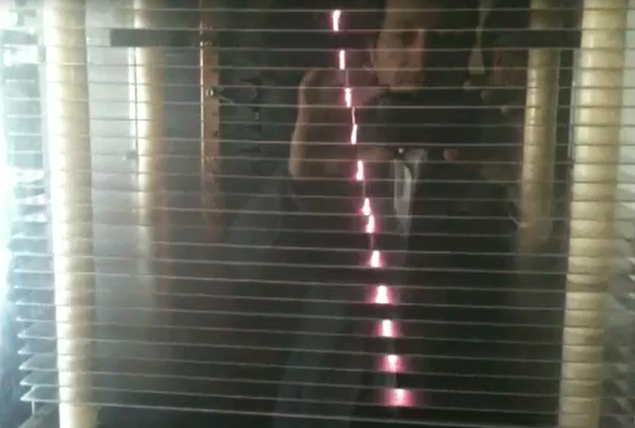The workshop, titled "Mu-Steel", centered on the problem of detecting small amounts of radioactive materials concealed within large amounts of scrap metal destined to be fused in steel factories. A truck loaded with metal parts may be the perfect place to dump a radioactive source, which is a costly thing to get rid of. If the source gets melted and becomes part of the production of other objects, of course the economic damage to the factory may be very large, hence the interest of detecting these sources with effective methods.
I have discussed the technique in another posting a couple of years ago, so I will not go into details again here. The general concept however is interesting to mention: one can use cosmic-ray muons to produce a 5-time "radiography" of a container, if the truck carrying it is made to transit and stop for a few minutes within a portal equipped with appropriate muon detector elements. The trajectory of muons -particles that interact only weakly with matter, and are thus sensitive to the nuclei of heavy elements- is deflected by their interaction with matter; by reconstructing the amount of deflection of a large number of muons, it is possible to reconstruct the image of the local density of matter within the container.
The researchers who are developing the technique have done a great deal of progress in the recent past. They showed a full design of a portal designed to screen full tracks, a set of examples of reconstruction of muon data with the 3-D image of small lead bricks concealed in scrap iron, and the new muon detectors designed and built for the purpose. The next step is to find industries who are interested in taking the project to the building phase.
 What captured the most my attention today at the workshop was a device that organizers had placed in the meeting room. I later learned that this usually rests in a exhibit area of the department, where I have failed to notice it for a long time. It is a muon detector made with a wafer of detection elements yielding small pink sparks at the location where the muon is going through. The wafer is complemented at the top and the bottom by sheets of plastic scintillator that provide the trigger for the sparks. A picture is shown on the right.
What captured the most my attention today at the workshop was a device that organizers had placed in the meeting room. I later learned that this usually rests in a exhibit area of the department, where I have failed to notice it for a long time. It is a muon detector made with a wafer of detection elements yielding small pink sparks at the location where the muon is going through. The wafer is complemented at the top and the bottom by sheets of plastic scintillator that provide the trigger for the sparks. A picture is shown on the right. It is quite nice to see this thingy in operation: one typically observes a nice muon track every couple of seconds (a screenshot with one such track is on the left). One should note that muons rain from the upper atmosphere with a frequency of about 100 per square meter per second (at sea level), so the device in question -which has an effective area of about a tenth of a square meter- should see a rate of about ten muons per second; however its efficiency is kept low, but still the rate is good enough. In the 20-seconds .MOV video available here, which I took during the coffee break, you can see half a dozen tracks.
It is quite nice to see this thingy in operation: one typically observes a nice muon track every couple of seconds (a screenshot with one such track is on the left). One should note that muons rain from the upper atmosphere with a frequency of about 100 per square meter per second (at sea level), so the device in question -which has an effective area of about a tenth of a square meter- should see a rate of about ten muons per second; however its efficiency is kept low, but still the rate is good enough. In the 20-seconds .MOV video available here, which I took during the coffee break, you can see half a dozen tracks.I should also mention that if you have been to CERN for a visit, you probably have noticed a similar device, but occupying a whole wall, in the permanent exhibit of building 33. I must say, however, that all the times I went there I found it out of order -this is five or six times in the course of the last three years. I hope they put it back in operation: seeing muons is really cool!



Comments